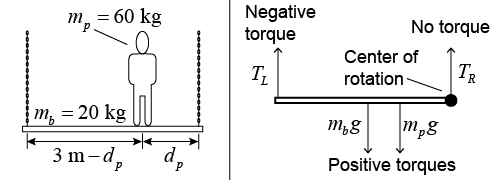|
The design process consists of a cycle of creation, analysis, and revision, in which a human need is to be satisfied with real-world materials. The design process makes use of physics while also accounting for cost and ensuring safety in unusual circumstances. A bridge or building will include a safety factor so that its critical components can withstand 10–20 times the forces expected in regular use; this provides some protection against rare but dangerous events. Extremely flexible structural elements such as ropes and chains only bear tension (pulling forces). Stiffer materials (such as beams) can withstand stress and shear (caused by pushing) as well as tension. 
|
|
safety factor, stress, tensile strength
|
|
|
|
Review problems and questions |
|
- A 35 kg lighting fixture hangs from a chain in a restaurant dining room. The builder chose a 4-mm-gauge chain with a breaking strength of 5,000 N, for this application. What safety factor does this imply?


|
The safety factor is approximately 14½. The lighting fixture weighs (35 kg)(9.8 N/kg), or 343 N. The chain has a breaking strength of 5,000 N. Since 5,000/343 = 14.6, the chain can withstand a momentary force that is about 14½ times its usual load. 
|
- A steel cable is used to lift a 24,000 kg container from a cargo ship. The tensile strength of steel is 2.50×108 N/m2.
- What is the minimum cross-sectional area of the cable that can support this load? (Do not include a safety factor.)
- What is the diameter of this cable?


|
Answer: - 9.4 × 10-4 m2
- 3.46 cm

|

- A 60 kg acrobat stands upon a 3-m-long, 20 kg beam that is hanging from two chains. He stands a distance dp from the right-hand chain. When computing torques, consider the right-hand end of the beam to be the center of rotation.
- Calculate the tension in each of the two chains when dp = 1.5 m (that is, when the acrobat is standing on the center of the beam).
- The acrobat moves a half-meter toward the right-hand chain (that is, to dp = 1.0 m). Calculate the tension in each of the two chains.
- How did TL and TR each change?
- Predict the values of TL and TR if the acrobat were to slide another 0.5 m to the right.
- Test your predictions by performing the necessary calculations.
- Suppose that a safety factor of 20 were required, no matter where the acrobat stood upon the beam. What minimum breaking strength (in newtons) would be required for each chain?


|
Answers: - The tension in each chain is 392 N when the acrobat stands upon the center of the beam. Since the arrangement is symmetric, the tension on each chain must simply be half the combined weight of the acrobat and the beam.
- TL = 294 N and TR = 490 N. Note that the total, TL + TR, remains the same (784 N).
- As the acrobat moves toward the right-hand chain, TL decreases and TR increases.
- The left tension will be (1/4) the total force while the right tension will be 3/4 the total force, or TL = 196 N and TR = 588 N.
- TL = 196 N and TR = 588 N
- The minimum breaking force required for either chain is approximately 14,000 N.
Solutions for three of the parts: - Write down the torques around the right-hand end of the platform: Solve for the left-hand tension and calculate its value: The right-hand tension is equal to the total weight (784 N) minus the tension in the left-hand support:
- Write down the torques around the right-hand end of the platform: Solve for the left-hand tension and calculate its value: The right-hand tension is equal to the total weight (784 N) minus the tension in the left-hand support:
- If the acrobat were move to the very end of the beam, the chain holding that end would have a maximum tension of 686 N. This is found by finding the torques about the right-hand side and solving for TL: Since the left-hand chain is supporting only 98 N, then the right-hand chain must support the remaining 686 N. Multiplying this by a safety factor of 20 yields 13,720 N, or approximately 14,000 N. Predicting tension values, testing your predictions, and then incorporating safety factors are all parts of the engineering design process.

|
Take a Quiz |
| |
|

